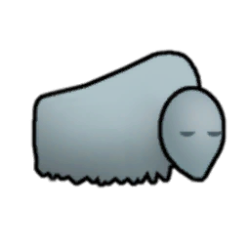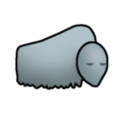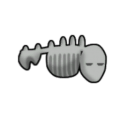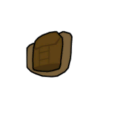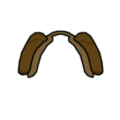Difference between revisions of "Muffalo"
(Undo of revision by 108.162.245.191. Text reads like a personal rant rather than a constructive edit.) |
|||
| (91 intermediate revisions by 30 users not shown) | |||
| Line 1: | Line 1: | ||
| − | {{ | + | {{Infobox main|animal |
| − | + | | name = Muffalo | |
| − | |name = Muffalo | + | | image = Muffalo east.png |
| − | |image = | + | | description = A large herding herbivore descended from buffalo and adapted for both cold and warm environments. While enraged muffalo are deadly, tamed muffalo are quite docile and can be used as pack animals.<br/>Nobody is quite sure why they're blue - it might even be some early genetic modification test that just never got changed. |
| − | |description = | + | | type = Animal |
| − | | | + | | movespeed = 4.5 |
| − | | | + | | min comfortable temperature = -55 |
| − | |bodysize = 2. | + | | max comfortable temperature = 45 |
| − | |healthscale = 1.75 | + | | flammability = 0.7 |
| − | | | + | | marketvalue = 300 |
| − | | | + | | filth rate = 16 |
| − | | | + | | woolname = muffalo wool |
| − | | | + | | sheartime = 15 |
| − | | | + | | wool = 120 |
| − | | | + | | herdanimal = true |
| − | | | + | | combatPower = 100 |
| − | | | + | | bodysize = 2.4 |
| − | | | + | | healthscale = 1.75 |
| − | | | + | | hungerrate = 0.535 |
| − | | | + | | diet = herbivorous |
| − | | | + | | leathername = bluefur |
| − | | | + | | wildness = 0.6 |
| − | | | + | | manhuntertame = 0 |
| − | | | + | | manhunter = 0.1 |
| − | | | + | | roamMtb = 2 |
| − | | | + | | trainable = none |
| − | | | + | | mateMtb = 12 |
| − | | | + | | packanimal = true |
| − | | | + | | gestation = 6.66 |
| − | | | + | | offspring = 1 |
| − | + | | lifespan = 15 | |
| − | | | + | | juvenileage = 0.25 |
| − | | | + | | maturityage = 0.3333 |
| − | | | + | | tradeTags = AnimalFarm, AnimalCommon |
| − | | | + | | attack1dmg = 13 |
| − | |livesin_temperateforest = | + | | attack1type = Blunt |
| − | |livesin_tundra = | + | | attack1cool = 2.6 |
| − | }} | + | | attack1part = head |
| + | | attack2dmg = 10 | ||
| + | | attack2type = Blunt | ||
| + | | attack2cool = 2 | ||
| + | | attack2part = front left leg | ||
| + | | attack3dmg = 10 | ||
| + | | attack3type = Poke | ||
| + | | attack3cool = 2 | ||
| + | | attack3part = front left leg | ||
| + | | attack4dmg = 10 | ||
| + | | attack4type = Blunt | ||
| + | | attack4cool = 2 | ||
| + | | attack4part = front right leg | ||
| + | | attack5dmg = 10 | ||
| + | | attack5type = Poke | ||
| + | | attack5cool = 2 | ||
| + | | attack5part = front right leg | ||
| + | | attack6dmg = 10 | ||
| + | | attack6type = Bite | ||
| + | | attack6cool = 2 | ||
| + | | attack6part = teeth | ||
| + | | attack6chancefactor = 0.5 | ||
| + | | livesin_temperateforest = 0.5 | ||
| + | | livesin_temperateswamp = 0.5 | ||
| + | | livesin_borealforest = 0.5 | ||
| + | | livesin_tundra = 2 | ||
| + | | livesin_coldbog = 0.5 | ||
| + | | livesin_icesheet = 0.1 | ||
| + | | livesin_seaice = 0.1 | ||
| + | }} | ||
| + | '''Muffalo''' are slow-moving, grass-grazing quadrupeds analogous to buffalo. | ||
| − | {{ | + | == Taming== |
| + | Muffalo can be found in {{Habitats}}. They can either be tamed by a [[Work#Handle|handler]] or self-tame in a random [[events|event]]. | ||
| − | + | Muffalo can be bought and sold in other [[Trade#Faction base|faction bases]] and from [[Trade#Bulk goods trader 2|bulk goods traders]]. Muffalo purchased from traders will be already tamed. | |
| − | |||
| − | == | + | == Summary == |
| − | + | {{Pen Animal Note|Muffalo}} | |
| + | Muffalo can be sheared for {{Icon Small|Muffalo wool}} {{P|Wool Amount}} [[muffalo wool]] ({{Icon Small|silver|16|{{#expr: {{Q|Muffalo wool|Market Value Base}}*120}}}}) every {{P|Shearing Interval Days}} days for {{Ticks|1700}} of work. Note that yield and shearing time are modified by the shearer's [[Animal Gather Yield]] and [[Animal Gather Speed]] respectively. | ||
| + | |||
| + | Muffalo are also [[pack animal]]s, and will carry up to {{P|Pack Capacity}} kg of weight in a [[caravan]]. They cannot be ridden. | ||
| + | |||
| + | == Analysis == | ||
| + | Muffalo arrive in large packs; a herd of muffalo can be a lifesaver in colder [[biome]]s. Two or three muffalo usually provide enough leather (or wool if you are willing to tame them) to make a parka as well as a generous amount of meat. But, if enraged, a herd can be a large threat to colonists. | ||
| + | |||
| + | As tamed animals, muffalo are a wool-producing pack animal, which can be found in colder biomes. In a [[tundra]] or [[ice sheet]], the only pack animal available is the muffalo. They can survive cold temperatures that would kill most other pack animals. Their wool and leather is also great for cold insulation. | ||
| + | * As a pack animal, [[horse]]s carry the same weight, but eat less. Horses can also be ridden. However, horses do not live in cold biomes (nor do they produce wool). Without considering horses, muffalo are otherwise great pack animals, holding more weight per food than any other alternative. | ||
| + | * As a wool-producing animal, [[alpaca]] and [[sheep]] produce more wool per day. Like horses, both alpaca and sheep do not live in cold biomes. | ||
| + | |||
| + | They are almost identical to [[bison]], the main differences being comfortable temperature, leather type, and wool type. Muffalo are also slower than both bison and baseline humans. This makes muffalo safer to hunt, though as muffalo are only 0.1 {{CS}} slower than humans, you should still take care while hunting. | ||
| + | |||
| + | == Training == | ||
{{TrainingTable}} | {{TrainingTable}} | ||
| + | == Health == | ||
| + | {{Animal Health Table|QuadrupedAnimalWithHooves}} | ||
| + | |||
| + | == Trivia == | ||
| + | The original texture was created by Tynan Sylvester himself in 2013, dating it to A2 or earlier and making it one of the oldest textures still in use.<ref>"''It's a pair of ellipses I dragged out in Photoshop in 2013, cut in half using the box-select tool. It filled its purpose, that's what matters!''" - Tynan Sylvester, [https://www.reddit.com/r/RimWorld/comments/wrky87/comment/ikv1nmc/?utm_source=share&utm_medium=web2x&context=3 WTF is the Muffalo's Face] on ''Reddit''.</ref> | ||
| − | + | == Gallery == | |
| + | <gallery> | ||
| + | Muffalo east.png|Muffalo facing east | ||
| + | Muffalo north.png|Muffalo facing north | ||
| + | Muffalo south.png|Muffalo facing south | ||
| + | Dessicated muffalo east.png|Muffalo decaying | ||
| + | </gallery> | ||
| + | <gallery> | ||
| + | Muffalo pack east.png|Packing bags facing east | ||
| + | Muffalo pack north.png|Packing bags facing north | ||
| + | </gallery> | ||
| + | == Version history == | ||
| + | * [[Version/0.12.906|0.12.906]] - Can now be shorn for wool and milked | ||
| + | * 1.1 (or earlier?) - They can no longer produce milk. Prior to this tamed females could be milked once every 2 days for 16 [[milk]]. | ||
| − | {{ | + | {{Nav|animal|wide}} |
[[Category:Animals]] | [[Category:Animals]] | ||
| − | [[Category:Wild]] | + | [[Category:Pack Animal]] |
| + | [[Category:Wild animal]] | ||
Latest revision as of 00:42, 16 July 2024
Muffalo
A large herding herbivore descended from buffalo and adapted for both cold and warm environments. While enraged muffalo are deadly, tamed muffalo are quite docile and can be used as pack animals.
Nobody is quite sure why they're blue - it might even be some early genetic modification test that just never got changed.
Base Stats
- Type
- Animal
- Flammability
- 70%
Pawn Stats
- Combat Power
- 100
- Move Speed
- 4.5 c/s
- Health Scale
- 175% HP
- Body Size
- 2.4
- Mass - Baby
- 28.8 kg
- Mass - Juvenile
- 72 kg
- Mass - Adult
- 144 kg
- Pack Capacity
- 84 kg
- Carrying Capacity
- 180 kg
- Filth Rate
- 16
- Hunger Rate
- 0.86 Nutrition/Day
- Diet
- herbivorous
- Life Expectancy
- 15 years
- Manhunter Chance
- 10%
- Manhunter Chance (Taming)
- 0%
- Trainable Intelligence
- None
- Wildness
- 60%
- Minimum Handling Skill
- 5
- Roam Interval
- 2 days
- Mate Interval
- 12 hours
- Maturity Age
- 0.333 years (20 days)
- Juvenile Age
- 0.25 years (15 days)
- Comfortable Temp Range
- -55 °C – 45 °C (-67 °F – 113 °F)
Production
- Meat Yield
- 336
 muffalo meat
muffalo meat - Leather Yield
- 96
 bluefur
bluefur - Wool Amount
- 120
 muffalo wool
muffalo wool - Shearing Interval
- 15 days
- Gestation Period
- 6.66 days
- Offspring Per Birth
- 1
Melee Combat
- Attack 1
- Head
13 dmg (Blunt)
19 % AP
2.6 second cooldown - Attack 2
- Front left leg
10 dmg (Blunt)
15 % AP
2 second cooldown - Attack 3
- Front left leg
10 dmg (Poke)
15 % AP
2 second cooldown - Attack 4
- Front right leg
10 dmg (Blunt)
15 % AP
2 second cooldown - Attack 5
- Front right leg
10 dmg (Poke)
15 % AP
2 second cooldown - Attack 6
- Teeth
10 dmg (Bite)
15 % AP
2 second cooldown
0.5 chance factor - Average DPS
- 3.1
- tradeTags
- AnimalFarm, AnimalCommon
Muffalo are slow-moving, grass-grazing quadrupeds analogous to buffalo.
Taming[edit]
Muffalo can be found in temperate forests, temperate swamps, boreal forests, cold bogs, tundra, ice sheets, and sea ice. They can either be tamed by a handler or self-tame in a random event.
Muffalo can be bought and sold in other faction bases and from bulk goods traders. Muffalo purchased from traders will be already tamed.
Summary[edit]
Muffalo are pen animals. Once tamed, pen animals cannot and do not need to be trained any further. But if left outside of a pen or caravan hitching spot, pen animals will eventually roam outside your colony. Making a caravan is not required to tie animals to a caravan hitching spot.
Muffalo can be sheared for ![]() 120 muffalo wool (
120 muffalo wool (![]() 324) every 15 days for 1,700 ticks (28.33 secs) of work. Note that yield and shearing time are modified by the shearer's Animal Gather Yield and Animal Gather Speed respectively.
324) every 15 days for 1,700 ticks (28.33 secs) of work. Note that yield and shearing time are modified by the shearer's Animal Gather Yield and Animal Gather Speed respectively.
Muffalo are also pack animals, and will carry up to 84 kg of weight in a caravan. They cannot be ridden.
Analysis[edit]
Muffalo arrive in large packs; a herd of muffalo can be a lifesaver in colder biomes. Two or three muffalo usually provide enough leather (or wool if you are willing to tame them) to make a parka as well as a generous amount of meat. But, if enraged, a herd can be a large threat to colonists.
As tamed animals, muffalo are a wool-producing pack animal, which can be found in colder biomes. In a tundra or ice sheet, the only pack animal available is the muffalo. They can survive cold temperatures that would kill most other pack animals. Their wool and leather is also great for cold insulation.
- As a pack animal, horses carry the same weight, but eat less. Horses can also be ridden. However, horses do not live in cold biomes (nor do they produce wool). Without considering horses, muffalo are otherwise great pack animals, holding more weight per food than any other alternative.
- As a wool-producing animal, alpaca and sheep produce more wool per day. Like horses, both alpaca and sheep do not live in cold biomes.
They are almost identical to bison, the main differences being comfortable temperature, leather type, and wool type. Muffalo are also slower than both bison and baseline humans. This makes muffalo safer to hunt, though as muffalo are only 0.1 c/s slower than humans, you should still take care while hunting.
Training[edit]
This animal can be trained as follows:
| Guard: | |
|---|---|
| Attack: | |
| Rescue: | |
| Haul: | |
*As of version 1.1.2610, all animals can be tamed. The percentage of likelihood of success depends on factors such as the Animals Wildness Percentage, Pawn Handling Skill, and others. More information can be found on the animals page.
Health[edit]
| Part Name | Health | Quantity | Coverage[1] | Target Chance[2] | Subpart of | Internal | Capacity[3] | Effect if Destroyed/Removed |
|---|---|---|---|---|---|---|---|---|
| Body | 70 | 1 | 100% | 26% | N/A[4] | - | Death | |
| Spine | 43.75 | 1 | 3% | 3% | Body | Moving |
−100% Moving[5] | |
| Stomach | 35 | 1 | 3% | 3% | Body | Digestion |
−50% Digestion | |
| Heart | 26.25 | 1 | 3% | 3% | Body | Blood Pumping |
Death | |
| Lung | 26.25 | 2 | 3% | 3% | Body | Breathing |
−50% Breathing. Death if both lost. | |
| Kidney | 26.25 | 2 | 3% | 3% | Body | Blood Filtration | −50% Blood Filtration. Death if both lost. | |
| Liver | 35 | 1 | 3% | 3% | Body | Digestion |
Death | |
| Neck | 43.75 | 1 | 22% | 5.5% | Body | Eating Talking Breathing |
Death | |
| Head | 43.75 | 1 | 75% | 2.475% | Neck | - | Death | |
| Skull | 43.75 | 1 | 25% | 1.2375% | Head | - | Cannot be destroyed Increasing Pain based on damage. | |
| Brain | 17.5 | 1 | 70% | 2.8875% | Skull | Consciousness |
Death Damage always results in scarring. | |
| Eye | 17.5 | 2 | 12% | 1.98% | Head | Sight |
−25% Sight. −100% if both lost. Damage always results in scarring. 0% Hit Chance against Blunt damage. | |
| Ear | 21 | 2 | 8% | 1.32% | Head | Hearing |
−25% Hearing. −100% if both lost. | |
| Nose | 17.5 | 1 | 10% | 1.65% | Head | - | - | |
| AnimalJaw | 17.5 | 1 | 10% | 1.65% | Head | Manipulation |
−100% Manipulation. Can no longer use Bite attack. | |
| Front Leg | 52.5 | 2 | 7% | 5.95% | Body | Moving |
−25% Moving. −50% if both lost. Can no longer use Hoof attack.[6] | |
| Front Hoof | 17.5 | 2 | 15% | 1.05% | Front Leg | Moving |
−25% Moving. −50% if both lost. | |
| Rear Leg | 52.5 | 2 | 7% | 5.95% | Body | Moving |
−25% Moving. −50% if both lost. | |
| Rear Hoof | 17.5 | 2 | 15% | 1.05% | Rear Leg | Moving |
−25% Moving. −50% if both lost. |
- ↑ Coverage determines the chance to hit this body part. It refers to the percentage of the super-part that this part covers, before its own sub-parts claim their own percentage. For example, if the base coverage of the super-part is 100%, and the coverage of the part is 20%, 20% of hits would hit the part, and 80% the super-part. If the part had its own sub-part with 50% coverage, the chances would be 10% sub-part, 10% part, 80% super part.
- ↑ Target Chance is the actual chance for each part to be be selected as the target when each part's coverage has been taken into account(I.E. Neck covers 7.5% of Torso but Head covers 80% of Neck so it actually has only a 1.5% chance to be selected). This is not pure hit chance, as different damage types propagate damage in different ways. See that page for details.
- ↑ Note that capacities can affect other capacities in turn. Only the primary effect is listed. See specific pages for details.
- ↑ This is the part that everything else connects to to be considered 'connected'.
- ↑ If Moving drops below 16% a pawn cannot move.
- ↑ A Blunt/Poke attack with cooldown of 2s. The actual Hoof is unrelated
Trivia[edit]
The original texture was created by Tynan Sylvester himself in 2013, dating it to A2 or earlier and making it one of the oldest textures still in use.[1]
Gallery[edit]
Version history[edit]
- 0.12.906 - Can now be shorn for wool and milked
- 1.1 (or earlier?) - They can no longer produce milk. Prior to this tamed females could be milked once every 2 days for 16 milk.
- ↑ "It's a pair of ellipses I dragged out in Photoshop in 2013, cut in half using the box-select tool. It filled its purpose, that's what matters!" - Tynan Sylvester, WTF is the Muffalo's Face on Reddit.
